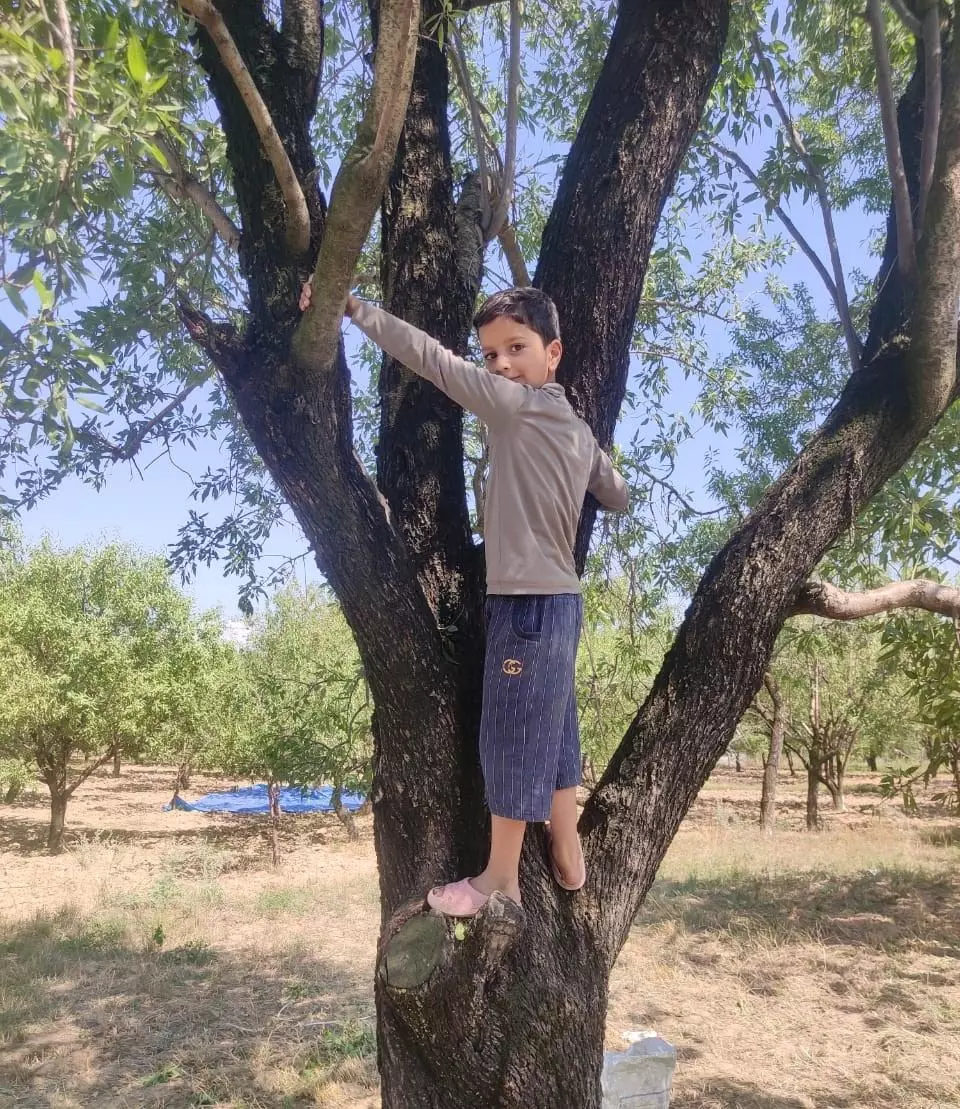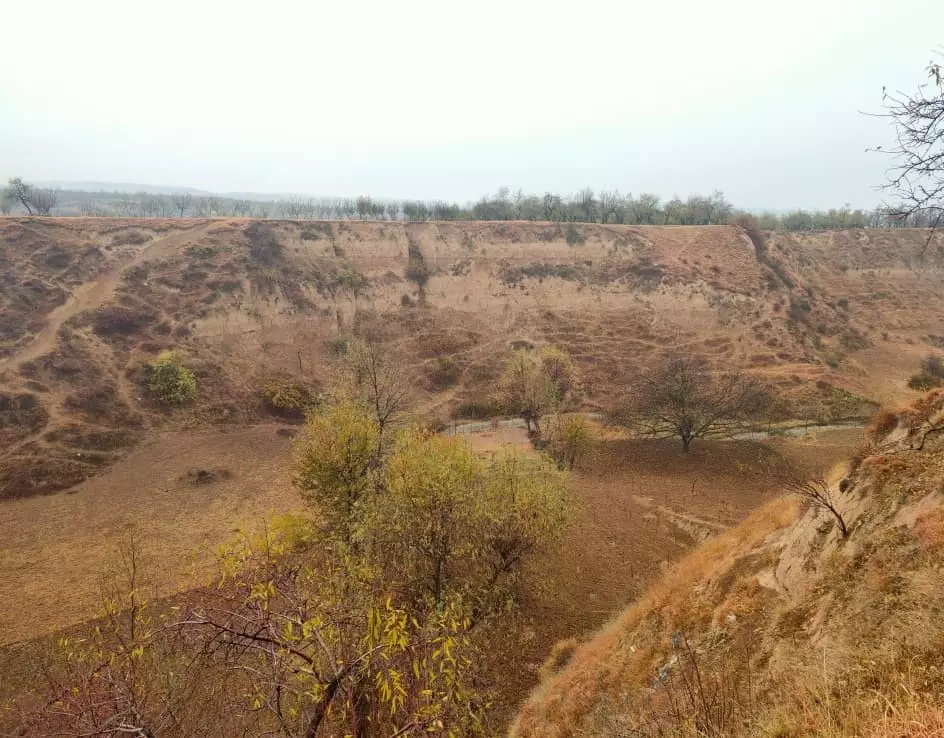
- Home
- India
- World
- Premium
- THE FEDERAL SPECIAL
- Analysis
- States
- Perspective
- Videos
- Sports
- Education
- Entertainment
- Elections
- Features
- Health
- Business
- Series
- In memoriam: Sheikh Mujibur Rahman
- Bishnoi's Men
- NEET TANGLE
- Economy Series
- Earth Day
- Kashmir’s Frozen Turbulence
- India@75
- The legend of Ramjanmabhoomi
- Liberalisation@30
- How to tame a dragon
- Celebrating biodiversity
- Farm Matters
- 50 days of solitude
- Bringing Migrants Home
- Budget 2020
- Jharkhand Votes
- The Federal Investigates
- The Federal Impact
- Vanishing Sand
- Gandhi @ 150
- Andhra Today
- Field report
- Operation Gulmarg
- Pandemic @1 Mn in India
- The Federal Year-End
- The Zero Year
- Science
- Brand studio
- Newsletter
- Elections 2024
- Events
Climate change to alleged lack of govt support, why Kashmir’s almond farms have given way to apple orchards
Cropped area for almonds shrunk from 16,374 hectares in 2006-07 to 4,177 hectares in 2019-20; production has dropped from 15,183 tonnes to 9,898 tonnes in same period, while J&K has produced 62 lakh metric tonnes of apples over the past three years

If Japan is known for its cherry blossom season, celebrated between late March and early May annually, with flower viewings, picnics, parties and performances, for generations of Kashmiris, spring would be synonymous with almond trees in bloom; the little white flowers lending a unique charm to its snow-tipped peaks and terraced slopes.“Almond blossoms were a part of our lives. Every...
If Japan is known for its cherry blossom season, celebrated between late March and early May annually, with flower viewings, picnics, parties and performances, for generations of Kashmiris, spring would be synonymous with almond trees in bloom; the little white flowers lending a unique charm to its snow-tipped peaks and terraced slopes.
“Almond blossoms were a part of our lives. Every spring, the entire village would celebrate the bloom. Now, there is less to celebrate,” rued Rayees Ahmad Mantoo, a 34-year-old farmer in Rohmoo village in Kashmir’s Pulwama district. It’s a beauty he fears the next generation may never get to feast their eyes on.
According to official estimates, in the 1990s, Jammu and Kashmir had more than 20,000 hectares under almond cultivation. The trees thrived on the fertile karewa land (thick sediments of sand, clay and silt) of Pulwama, Budgam, and other parts of the Kashmir Valley, with the produce earning a reputation for its quality and taste. Pulwama, especially, was a hub of almond cultivation, with orchards spread across the district, remember old timers in the region.
By 2006–07, however, the cropped area for almonds in Kashmir had shrunk to 16,374 hectares, and by 2019–20 it had fallen further to 4,177 hectares, reveals government data.
Also read: Why ration loss is pushing FPO directors to desperation, likely resignation
For decades, Kashmir’s almonds had been in demand both within the state and among consumers outside the Valley. The temperate climate, unique soil composition, and long farming history made the produce distinctive. The crop had the potential to sustain rural economies and provided a steady income to many families, say farmers. But climate change, the extensive care needed by the crop to mature and alleged institutional neglect of almond farming, has increasingly pushed farmers to migrate to apple cultivation.
The influx of California almonds into the Indian market too has significantly impacted almond growers in Kashmir, they say. In the 2023–24 crop financial year, shipments of California almonds to India reportedly exceeded 400 million pounds, marking a 21 per cent increase compared to the previous year. The surge in imports took a toll on the demand for Kashmiri almonds.
Across vast stretches of Kashmir, almond orchards have given way to apple gardens in the past decade, the shift picking up pace in the past five years.
Standing amidst the few remaining almond trees on his land, which in 2020 had still spanned about 3.1 acres, but now covers only about 0.9 acres, Mantoo added, “In 2020, this land yielded around 25 quintals of almonds. But with market prices dropping sharply, it was no longer a commercially viable crop. I had to convert 2.25 acres of almond orchards into apple cultivation.” Imtiyaz Ah Bhat, a farmer in Budgam district, and Aabid Shafi of Shopian, have similarly gotten rid of their almond trees.
In Kashmir, almond trees typically flower between the last week of March and the first week of April, with the harvest season extending from mid-August to the first week of September. The crop is considered ready to be picked when the hull changes from green to a yellowish colour and begins to crack or split along the suture.

Seven-year-old Abu Hanzla, son of Rayees Ahmad Mantoo, climbs an almond tree during the harvest season in Kashmir’s Pulwama district. Photo by special arrangement
According to a study by fruit scientist MK Verma, titled Almond Production Technology, “blossoms can often withstand temperatures from -2.2 to -3.3°C for a short time, but if low temperatures continue for many hours, they get damaged”. In recent years, early-spring frosts and unseasonal rains have damaged almond blossoms, complain farmers. “Sometimes the flowers bloom, but within days a cold snap destroys them. After all the work, we watch the harvest vanish,” said Matoo. Labour cost, pruning, harvesting, and maintenance often exceeded the money earned from selling the produce. “I could spend a month harvesting and still not earn enough to pay the workers,” he added.
Also read: Punjab floods: How Ravi’s fury, embankment collapse brought calamity to farmers
According to Dr. Athar Bashir, a research scholar at Sher-e-Kashmir University of Agricultural Sciences and Technology (SKUAST), weather and climate challenges remain among the biggest hurdles for almond cultivators. “Almond trees are among the earliest to flower in Kashmir, which makes them highly vulnerable,” he said. If cold waves, strong winds, or unexpected showers occur during the bloom period, the delicate blossoms or newly formed fruits are often damaged. A single spell of late snow in March or April could wipe out an entire season’s effort. At the same time, high temperatures and lack of soil moisture could cause leaves to dry as almost all almond-growing karewa land in Pulwama relied on rain and had little access to irrigation, Bashir explained.
Majid Ahmad from Gosso, a Pulwama-based farmer, alleged that while “construction of dams and canals had been initiated to irrigate almond orchards, the projects were never completed”. Citing “lack of official support” as reason for the increasing disinterest among farmers to engage in almond cultivation, Gosso added: “We repeatedly requested authorities to educate us on almond cultivation and production, but our appeals were ignored”. While authorities introduced new varieties of crops like paddy and apples, almond cultivation was largely neglected, he claimed.
Gosso’s family once had a 40-kanal almond orchard (approximately five acres), but had to convert around 15 kanals (1.875 acres), into apple cultivation. Recalling the good days of almond farming, he said, “There was a time when three kilograms of tea could be bought for just one kilogram of almonds. Now, for three kilograms of almonds, we can purchase only one kilogram of tea.”
Also read: How ‘unfair pricing’ of leaves is brewing a storm in Assam’s small tea gardens
According to official figures, Jammu and Kashmir has produced about 62 lakh metric tonnes of apples over the past three years. Farmers cite governmental push to high-density apple farming as one of the reasons for almond orchards giving way to apples in the Valley; the latter thrive in temperate climates characterised by cold winters and moderate summers, conditions that are prevalent in Kashmir. Between 2016-17 and January this year, a reported 836 hectares have been brought under high-density apple cultivation, with Pulwama district emerging as one of the biggest producers, shows data. Meanwhile, alleged failure to introduce improved or high density varieties has led almond production to drop from 15,183 tonnes in 2006-07 to 9,898 tonnes in 2019-20.

Aabid Shafi, a farmer who converted half an acre of almond land into an apple orchard. Photo by special arrangement
For Mantoo, switching to apple cultivation has eased the immediate financial pressure, but is not without its challenges. Apples, too, require intensive care and pruning, regular irrigation, and protection from pests. Mantoo has invested heavily in saplings, fertilizers, and labour, he says. “At the time we decided to convert the orchard [around 2020], almond prices had plummeted to around 80 rupees per kilogram,” Mantoo recalled. “It seemed impossible to continue [with almond cultivation].”
In Kashmir, a comparison of almond and apple cultivation reveals contrasting investment profiles and returns. According to "Economics of Medium Density Almond Cultivation in Kashmir Valley" a study by Masudul Haq Wani and Arshad Bhat, almond farming under medium-density orchards requires an investment of around ₹103,000 per hectare, yielding approximately three tonnes per hectare. In contrast, high-density apple orchards demand a significantly higher initial investment of roughly $48,611 (around ₹45 lakh) per hectare, according to the 2021 study in the International Journal of Fruit Science by MH Wani, Arshad Bhat, and SH Baba. But compensate for this with far greater productivity, producing up to 61.6 tonnes per hectare of predominantly Grade-A fruit.
Apple farming in Kashmir is often perceived as “easier” than almond cultivation because of greater institutional support, better market access, and subsidies under government schemes. But unseasonal rains, late frost, hailstorms, or sudden heatwaves can damage blossoms, reduce fruit set, or spoil harvests. “Apples are profitable only if everything goes right. One hailstorm or pest outbreak can ruin months of work,” conceded Mantoo.
As the apple harvest reached its peak in late August–September this year, Kashmir’s fruit growers were blindsided by repeated landslides and floods, which forced the closure of the Srinagar–Jammu National Highway — the Valley’s lifeline for transporting apples to major markets — causing widespread damage and financial loss. By mid-September, estimates show growers and traders had already lost over Rs 1,000 crore.
Also read: How Makhana cultivation in Bihar leaves farmers struggling for survival
Talking to The Federal, Dr Amit Kumar, a professor at SKUAST, cited “lack of good, high-yielding local varieties” as a reason for the decline in almond production in Kashmir. “Most of what is available is imported, and it is difficult for farmers to establish orchards with these owing to environmental incompatibilities and regulatory requirements,” he said.
Kumar added that almond cultivation required careful selection of compatible varieties to ensure a good fruit set. “Farmers need guidance on selecting late-blooming varieties and synchronising flowering.” He also highlighted the role of government schemes. “Currently, subsidies and support are focused more on apple cultivation, which encourages farmers to shift from almonds to apples. If similar support were provided for almonds, it could help revive this traditional crop.”

Fertile karewa land on which almond trees thrive in Kashmir. Photo by special arrangement
Javid Ahmad, chief horticulture officer, Pulwama, acknowledged the decline in almond cultivation, but insisted the department was working on reviving the crop. “Farmers look for better rates, and since our existing almond varieties are not market-preferred, many have shifted land towards apple orchards,” he said.
The official claimed that the department was introducing late-blooming and market-preferred almond crop varieties, alongside new technologies to boost production. “We want to ensure better profitability for farmers. The cost of setting up almond orchards is lower than of apples, the annual maintenance is less, and once market-demanded varieties are established, returns can be strong,” he said.
His words would be music to Mantoo’s ears, who still retains hope for his remaining almond trees. “I have not given up on almonds entirely,” he said, standing beside a small cluster of the trees. “If the government supports us with good saplings, irrigation, and fair prices [on the produce], I can bring back more of the orchard. The trees can still live.” And almond blossoms would again mark the advent of spring in Kashmir.
